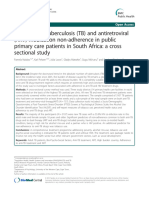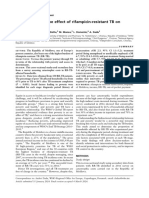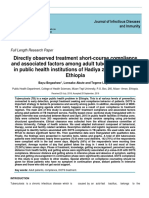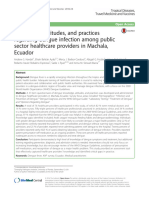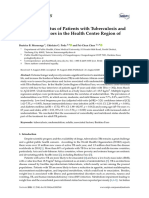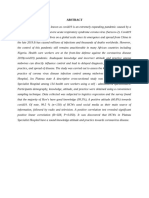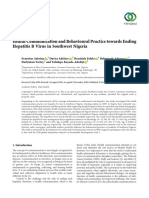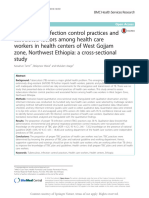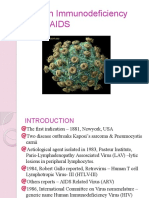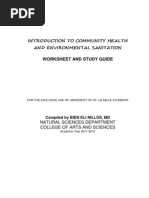BMC Research Notes: Research Article Open Access
BMC Research Notes: Research Article Open Access
Uploaded by
septia mutiaraCopyright:
Available Formats
BMC Research Notes: Research Article Open Access
BMC Research Notes: Research Article Open Access
Uploaded by
septia mutiaraOriginal Title
Copyright
Available Formats
Share this document
Did you find this document useful?
Is this content inappropriate?
Copyright:
Available Formats
BMC Research Notes: Research Article Open Access
BMC Research Notes: Research Article Open Access
Uploaded by
septia mutiaraCopyright:
Available Formats
Mda et al.
BMC Res Notes (2016) 9:373
DOI 10.1186/s13104-016-2183-3
RESEARCH ARTICLE
BMC Research Notes
Open Access
Patients infected bytuberculosis
andhuman immunodeficiency virus facing their
disease, their reactions todisease diagnosis
andits implication abouttheir families
andcommunities, inBurkina Faso: a mixed focus
group andcross sectional study
ZiemlClmentMda1,2, TlesphoreSom3, IssiakaSombi4,5, DaoudaMar6, DonaldE.Morisky7
andYiMingArthurChen8,9*
Abstract
Background: Patients facing tuberculosis (TB) and human immunodeficiency virus (HIV) infection receive particular
care. Despite efforts in the care, misconceptions about TB and HIV still heavily impact patients, their families and com
munities. This situation severely limits achievement of TB and HIV programs goals. This study reports current situa
tion of TB patients and patients living with HIV/AIDS (PLWHA) facing their disease and its implications, by comparing
results from both qualitative and quantitative study design.
Methods: Cross sectional study using mixed methods was used and excluded patients co-infected by TB and HIV.
Focus group included 96 patients (6 patients per group) stratified by setting, disease profile and gender; from rural
(Orodara Health District) and urban (Bobo Dioulasso) areas, all from Hauts-Bassins region in Burkina Faso. Quantitative
study included 862 patients (309TB patients and 553 PLWHA) attending TB and HIV care facilities in two main regions
(Hauts-Bassins and Centre) of Burkina Faso.
Results: A content analysis of reports found TB patients and PLWHA felt discriminated and stigmatized because of
misconceptions with its aftermaths (rejection, emotional and financial problems), mainly among PLWHA and women
patients. PLWHA go to healers when facing limited solutions in health system. There are fewer associations for TB
patients, and less education and sensitization sessions to give them opportunity for sharing disease status and learn
ing from other TB patients. TB patients and PLWHA still need to better understand their disease and its implication.
Access to care (diagnosis and treatment) remains one of the key issues in health system, especially for PLWHA. Indi
vidual counseling is centered among PLWHA but not for TB patients. With research progress and experiences sharing,
TB patients and PLWHA have some hope to implement their life project, and to receive psychosocial and nutritional
support.
Conclusion: Despite international aid, TB patients and PLWHA are facing misconceptions effects. There is a need
to reinforce health education towards patients and healers, inside community, health centers and associations, and
for specific settings. International aid must be adapted to specific targets and strategies implementing programs.
*Correspondence: arthur@kmu.edu.tw
9
Center forInfectious Disease andCancer Research (CICAR), Kaohsiung
Medical University, Kaohsiung City, Taiwan
Full list of author information is available at the end of the article
2016 Mda etal. This article is distributed under the terms of the Creative Commons Attribution 4.0 International License
(http://creativecommons.org/licenses/by/4.0/), which permits unrestricted use, distribution, and reproduction in any medium,
provided you give appropriate credit to the original author(s) and the source, provide a link to the Creative Commons license,
and indicate if changes were made. The Creative Commons Public Domain Dedication waiver (http://creativecommons.org/
publicdomain/zero/1.0/) applies to the data made available in this article, unless otherwise stated.
Mda et al. BMC Res Notes (2016) 9:373
Page 2 of 10
Maintaining psychosocial and nutritional support is crucial for better outcomes of medication adherence. Individual
counseling has to be centered among TB patients and PLWHA.
Keywords: Tuberculosis, HIV, Discrimination, Stigmatization, Healer, Gender, Preventive medicine, Global health
Background
Tuberculosis (TB) and human immunodeficiency virus
(HIV) infection remain among public health priorities
throughout the world. TB prevalence rate was 397 (179
654) per 100,000 populations with 20 % of cases tested
HIV positive in 2009 [1]. The prevalence of HIV among
adults aged 1549 years in Burkina Faso was 2.1 % in
2001 and 1.6% in 2007 [2].
Facing high rates of TB and HIV infection, Burkina
Faso receives different aid from international (bilateral and multilateral) levels. Indeed, the financing of TB
(90100%) [3, 4] and HIV (62.6%) [4] programs are primarily from international level (from bilateral and multilateral cooperation, international non-governmental
organizations-NGOs mainly Global Found, and international foundations and firms). Despite the efforts from
national and international levels, new TB cases are growing to 2660 in 2006 at 3041 cases 2010 [1, 5]. The percentage of TB treatment failure is growing with 7.0% in
2007 and 8.5 % in 2009 [1, 5] with an estimated multidrug resistance cases to anti-tuberculosis drugs (MDRTB) 2009 among new pulmonary TB cases notified of 34
(092) and among retreated pulmonary cases notified
of 88 (0230) [1]. The percentage of population in need
of treatment with access to antiretroviral drugs in Burkina Faso was 60% in 2009 [2]. There is a need to deeply
understand the specific context and needs about TB and
HIV infection.
Misconceptions exist related to the knowledge, attitude, perception and practices about TB at the individual
and community level [613]. The consequences of the
misconceptions are discrimination and stigmatization
and the interpretations of the illness and the wellness
about TB and HIV infection in rural and urban community. Additionally, this can lead to lack of compliance in
continuing treatment [14] resulting in drug resistance.
The percentages of confirmed TB multi-drug resistance
(MDR-TB) among the TB cases tested for MDR-TB in
2009 and 2010 are growing with 34 and 39% respectively
[1].
Women facing TB infection fear more the psychosocial consequences and their social isolation [15, 16]
than the actual disease itself. Issues related especially to
TB infection, additional problems include the TB case
management (the organization around the case diagnosis, the treatment, and the care), the characteristics of
the patient, the patient in his community and his family,
the support received, the geographical access to care,
the poverty, and the experience about the use of health
services [17]. Moreover many HIV-infected patients do
not understand the importance of the diagnosis and may
look for alternative care, such as consulting village healers [18].
The purpose of this study is to report the current situation of TB patients and patients living with HIV/AIDS
(PLWHA) facing their disease and its implications in
Burkina Faso.
Methods
Study setting
This cross sectional study was undertaken in health centers and NGOs located in the Centre and Hauts-Bassins
regions of Burkina Faso. These two regions represent
about 40% of the total annual TB cases nationwide, have
the highest HIV prevalence and have the largest number
of NGOs providing antiretroviral treatment (ART) in the
country Ref. [5, 19].
Study design
Cross sectional study using mixed method (qualitative
and quantitative) was used; TB and HIV co-infected
patients were excluded. The qualitative study was been
conducted before the quantitative one; it highlighted the
attitudes and opinions of the interviewees. The quantitative study measured the amount of interviewees who had
a certain behavior.
The qualitative study design
Planned for the period from 2nd to 10th July 2010, a total
of 16 focus groups were held with 6 persons per group.
Patients were selected in Hauts-Bassins region, both
from rural area (Orodara Health District) and urban
area (Bobo Dioulasso). These patients were not involved
in design of the quantitative study. Patients were stratified into groups by setting and by gender. The 16 focus
groups included 2TB female and 2TB male groups from
the rural area; 2 TB female and 2 TB male groups from
urban area; 2 patients living with HIV/AIDS (PLWHA)
male and 2 PLWHA female groups from rural area; 2
PLWHA male and 2 PLWHA female groups in urban
area. The group members were recruited with the help of
health workers who informed the patients and negotiated
the appointment time. Another appointment was negotiated for the focus group. The place of the focus group
Mda et al. BMC Res Notes (2016) 9:373
was in the TB detection and treatment Center (TDTC)
for the TB patients and the NGOs for the PLWHA. The
focus group were conducted to emphasize relevant questions related to attitude, beliefs, stigmatization, relation
patient-to-patient, community support. PLWHA with TB
co-infection were excluded.
A standardized list of open-ended questions was used
for discussions. This list was created by using themes
retained for the discussions. Some of these themes
derived from individuals interviews we undertake prior
the focus group discussions. Some of the themes used
are listed below: patient reaction to disease diagnosis,
perception of the disease (self-esteem, quality of life, contamination by disease, prevention of the disease, hope
of the patients, etc.); the life experiences and the sharing of the disease status; the aspects related to gender;
the behavior patient-others-patient; the observance of
the treatment (difficulties, constraints, life experiences,
etc.); diagnosis and treatment costs; changing needs due
to the disease (family support/aid, participation in social
activities, work status, etc.); and the relationships and the
future of the patient.
Discussion on a specific topic area continued until no
new information was generated. Group discussions were
tape-recorded and transcribed, and themes were identified through independent content analysis of the transcriptions and assistant moderator notes.
One moderator with great experience in focus groups,
facilitated all the discussions undertaken in local language (Dioula) or in French. He was assisted by a nurse
also fluent in Dioula and French. We used a focus group
guide, ensured consistent data collection across groups
and provided flexibility to obtain clarification [20, 21].
To minimize social desirability [22], participants were
reminded that the facilitators had no link with the health
department. They were not working in the health centers
and associations-NGOs concerned by the survey.
Focus groups were audio recorded and transcribed
verbatim for analysis using a computer-based qualitative
software program (QSR NVIVO 2.0). All French transcripts were translated in English by the moderator to
ensure accuracy.
Content analysis was run by examining the major
themes and patterns that emerged from the data, using
Concept Analysis, an inductive approach for constructing and confirming theory through systematic data coding [23].
To control for subjectivity during analysis and ensure
inter-coder agreement, two researchers independently
coded the data and then the two researchers compared
the results. Inconsistencies and disagreements in coding
were discussed and resolved before final analysis.
Page 3 of 10
The quantitative study design
In the Centre region, TB patients were identified from
data provided by the National TB Diagnosis, Treatment and Research Centre, and by the Health Districts
(HDs), of Boulmiougou, Baskuy, Sig-Noghin, Bogodogo, and Nongr-Massom. In the Hauts-Bassins region,
TB patients were identified from data provided by the
Regional TDTC, Souro Sanou National Teaching Hospital (SSNTH) and by theHDs of Orodara, Do, Dafra, Lena,
Hound, and Karangasso-Vigu.
PLWHA patients were identified from data provided by
various NGOs and HDs, which were the same as those
for the TB patients. The NGOs were the AssociationEspoir-Vie (AES) and Responsabilit-Espoir-Vie-Solidarit (REVS+) from Bobo Dioulasso in the Hauts-Bassins
region and the Association des Jeunes pour la Promotion
des Orphelins (AJPO) from Ouagadougou in the Centre
region. HIV and TB statuses were confirmed from the
medical records of each patient.
The sample size was calculated using the online sample size calculation software provided by RASOFT [24].
A common margin of 5 % was used. Thus a confidence
level of 95% was chosen, with a response distribution of
50% and a power of 80%. The distribution was assumed
to be normal and, knowing that the total TB cases for the
regions were 1832 in 2008 [5, 19], the smallest TB sample
size expected was 316 TB cases for the two regions. In
terms of HIV sample size, the normal rule of having one
case for at least two controls was applied, thus at least
600 HIV cases were needed.
This study has been planned for the period from 1st
to 30th August 2010 after advice and guidance were
obtained from the National TB program of Burkina Faso,
together with expert opinion from the West African
Health Organization.
A consecutive (successive) method was used for patient
recruitment. The inclusion criteria were met when the
patient was a confirmed TB case from a TB clinic and
was undergoing anti-tuberculosis treatment. Similar criteria were used for HIV cases from AIDS clinics under
HAART. The patients were required to be 15 years or
older and living in the study setting. Cases from both
sexes were included. After the cases were identified, this
study included two profiles of patients: HIV infected
patients and TB patients only. The co-infected patients
for TB and HIV are excluded.
After obtaining informed consent from each patient,
a face to face interview was conducted using a semistructured questionnaire. For that, we used the information gathered by qualitative study to elaborate the
semi-structured questionnaire consisting of two parts:
the socio-demographic information of the patient and
Mda et al. BMC Res Notes (2016) 9:373
Page 4 of 10
general questions about the self and social experience of
the disease: adapted attitude index [25], adapted perception index (discrimination, stigma and isolation) [26],
and awareness of disease transmission. Additional information was gathered about psychosocial and behavioral
information.
The interviewer recorded and completed the individuals information during the interview (1520min). The
remaining section of the questionnaire lasted approximately 2530min.
Before conducting the final survey, the questionnaire underwent pre-testing in order to reduce bias
and to better control the time needed to complete the
questionnaire.
The data was entered into EPIDATA and analyzed
using the SPSS PC statistical package, version 18.0. The
cut-off point for continuous variables was the median.
The level of significance was 0.05. A comparison of the
variables, between the HIV only infected patients and
those having tuberculosis, was carried out using the Chi
square test for categorical data and t test for continuous
data. The p value is identified significance between TB
and HIV patients.
The mixed methods design strategies
An initial phase of qualitative data collection and analysis
has been conducted and followed by a phase of quantitative data collection and analysis: sequential exploratory
design. The purpose was to specify and quantify findings
from other methods.
From the attributes used for the qualitative study, the
same were used as the guidance for the redaction both
qualitative and quantitative studies matching the trend
of the results. The data were from the following themes
or attributes: reactions to disease diagnosis, perception
of the disease, experiences lived with the relatives of the
patient and his community about the disease, aspects
related to gender, sharing of the disease status and behavior patient-others-patient, observance of the treatment
and costs of diagnosis and treatment, and patient needs
and perspectives.
Both results have been presented using ad-hoc
approach.
Research approval andethics
The present study was approved by the Research Ethics
Committee of Burkina Faso and the Ministry of Health in
July 2010. These approvals contributed a lot for the carrying out of the study in the Target regions.
Informed consent of the interviewees was sought and
granted. Also, participants anonymity and confidentiality were ensured.
Results
Participants andsamples characteristics
The qualitative study has been conducted from 7th to
14th July 2010. Table1 shows the characteristics of the 96
participants recruited to the qualitative design study.
About the quantitative study conducted from 1st
August to 8th October 2010, a total of 862 patients,
including 309 (35.8 %) TB patients and 553 (64.2 %)
PLWHA participated in this study. 52.0 % were from
Hauts-Bassins region and 48.0 % from Centre region.
There was no difference statistics between both Centre and Hauts-Bassins settings; even the Hauts-Bassins
region is more rural than the Centre region. In brief, the
mean age of the PLWHAs was 36.510.6years old, and
57.1% were female gender (see Table2 for more details).
Triangulation ofresults fromboth quantitative
andqualitative study
For reactions facing to disease diagnosis, perception of
the disease and experiences lived with the relatives of the
patient and his community about the disease, patients
from both quantitative and qualitative study perceived as
grave diseases and faced stigma, perceived bad attitude
towards TB/HIV and were discriminated against or isolated. Related to gender, women were exposed to social
Table1 Characteristics ofstudy participants inthe qualitative study
Type ofparticipants
TB
Patients living with
HIV (PLWHA)
Focus group
discussions (n=16)
Gender
Number of
patients (n=96)
Zones
represented
Age [mean
(range)]
Male
12
Rural
34 (1652)
Male
12
Urban
35 (1756)
Female
12
Rural
32 (1549)
Female
12
Urban
33 (1650)
Female
12
Rural
34 (1758)
Female
12
Urban
34 (1855)
Male
12
Rural
35 (1654)
Male
12
Urban
37 (1757)
Mda et al. BMC Res Notes (2016) 9:373
Page 5 of 10
Table2 Socio-demographic variables, association member status andcost ofdiagnosis andtreatment bypatient profile
Items
TB (n=309)
HIV (n=553)
Total (n=862)
p*
Region
Hauts-Bassins
150 (48.5)
298 (53.9)
448 (52.0)
Centre
159 (51.5)
255 (46.1)
414 (48.0)
0.151
Area
Rural
227 (73.5)
149 (26.9)
376 (43.6)
Urban
82 (26.5)
404 (73.1)
486 (56.4)
<0.001
Sex
Female
87 (28.2)
405 (73.2)
492 (57.1)
222 (71.8)
148 (26.8)
370 (42.9)
<36.5years old
203 (65.7)
280 (50.6)
483 (56.0)
36.5years old
106 (34.3)
273 (49.4)
379 (44.0)
Male
<0.001
Age group
<0.001
Education level
No educated
144 (46.6)
270 (48.8)
414 (48.0)
Educated
165 (53.4)
283 (51.2)
448 (52.0)
238 (77.0)
490 (88.6)
728 (84.5)
71 (23.0)
63 (11.4)
134 (15.5)
No
305 (98.7)
534 (96.6)
839 (97.3)
Yes
4 (1.3)
19 (3.4)
23 (2.7)
0.579
Profession
Others
Private and public sector
<0.001
Member of health mutual
0.099
Member of association since you know your disease status
No
286 (92.6)
263 (47.6)
549 (63.7)
Yes
23 (7.4)
290 (52.4)
313 (36.3)
<0.001
First choice for consultation when sick
Healers
47 (15.2)
118 (21.3)
165 (19.1)
Clinics
262 (84.8)
435 (78.7)
697 (80.9)
175 (56.6)
0 (0.0)
175 (20.3)
47 (15.2)
27 (4.9)
74 (8.6)
0.038
How expensive do you think TB diagnosis and treatment is in your country?
Free of charge
Reasonably priced
Somewhat/moderately expensive
63 (20.4)
204 (36.9)
267 (31.0)
Very expensive
24 (7.8)
322 (58.2)
346 (40.1)
<0.001
* The p values were performed based on the calculation of the Chi square test
and financial problems. HIV groups participated in education and sensitization sessions related to activities from
associations-NGOs than TB patients. For both TB and
HIV patients, treatment emerged as key challenge for
patients. Related to their needs and perspectives, PLWHA
were more expressed than TB patients and support can
be encouragement, advice, psychosocial support, food,
health education, and home visits, was really helpful. All
patients still hoped to receive support primarily in the
form of medicines and supplemental nutrition.
Reactions todisease diagnosis, perception ofthe disease
All patients were shocked hearing about having TB
or HIV. TB and HIV, locally called white cough and
spider, are still perceived as grave diseases. At the
announcement of their status, all patients felt bad and
associated the diagnosis to a death sentence. Moreover, they expressed fear because they thought about the
interpretation of the disease in the community: having
TB means you may have HIV, and vice versa. Indeed,
30.6% of TB and PLWHA patients from the total sample
size feared that other persons would know their disease
status, especially about TB patients (37.5%) as shown in
Table4. TB and PLWHA patients faced stigma, perceived
bad attitude towards TB/HIV and were discriminated or
isolated (Table4). For TB and PLWHA patients in focus
group, some symptoms such as losing weight, fatigue and
fever were perceived to indicate the existence of one of
Mda et al. BMC Res Notes (2016) 9:373
both TB and HIV infections. Some people with TB and
HIV infections had misconceptions of the way in which
they can transmitted the disease, for example, by simple
contact, or from eating from the same plate or utensils.
The gravity of the HIV infection is greater expressed by
PLWHA patients who seek care with healers, as confirmed by 21.3% of PLWHA patients (Table2); because
they think that medical facilities do not have solution for
them.
Experiences lived withthe relatives ofthe patient andhis
community aboutthe disease
Across all focus groups, TB patients and PLWHA felt
that their friends and relatives distanced themselves after
learning their status. They still perceived stigmatization
and some (more related to PLWHA) lost their home and
job because of their status. Indeed, about 93 (10.8 %)
patients had to change their housing after contracting
their illness. Indeed, up to 12.7 % of PLWHA patients
pointed out this fact (Table3). There was a proportional
difference between patient groups (p=0.018). Unfortunately, 131(14.7 %) patients revealed that they had lost
their job following their disease diagnosis (Table3); there
was no proportion difference between patient groups
(p = 0.484). Up to 683 (79.2 %) of TB and PLWHA hid
their disease status from others (Table 3); among the
683 TB patients and PLWHA who revealed their status, 19.5 % informed their partners, 32.5 % informed
family members, 15.4 % informed health workers, and
23.7 % informed a staff of the association. Furthermore,
668 (77.5 %) patients felt that the relatives and friends
talked about them when they were not present (Table3).
At least 124 (14.4%) patients said that they stayed away
from people in order to avoid rejection (Table 3); There
was proportion difference between patient groups
(p<0.001). Some patients recognized that not all people
behaved this way, as revealed by focus groups. To avoid
being discovered as TB patients, some of the TB patients,
mainly from rural setting, preferred to go outside their
community for treatment because under DOTS, they will
be identified as TB patients by the daily appointments at
the health centers. Indeed 737 (85.5 %) patients agreed
that they were bothered by others because they are TB
patients or PLWHA; and 58.2 % of PLWHA patients
(were more concerned by this issue (Table4). There was
proportion difference between patient groups (p<0.001).
Although all patients reported that they received information on how to avoid transmitting the disease to others; only 703 (81.6 %) patients were afraid of spreading
the disease to others (Table4). Indeed, up to 483 (56.0%)
patients never used condoms (Table 4). In addition,
Page 6 of 10
Table3Description of the variables related to psychosocial andbehavioral variables bypatient profile
Items
TB
(n=309)
HIV
(n=553)
Total
(n=862)
p*
Did your housing change since you know that you are sick?
No
286 (92.6)
483 (87.3)
769 (89.2)
Yes
23 (7.4)
70 (12.7)
93 (10.8)
0.018
Do you lose your job because you are TB or HIV patient?
No
270 (87.4)
492 (89.0)
762 (85.3)
Yes
39 (12.6)
61 (11.0)
131 (14.7)
0.099
Do you stay away from people in order to avoid rejection?
Totally agree
14 (4.5)
2 (0.4)
16 (1.9)
Rather agree
53 (17.2)
55 (9.9)
108 (12.5)
Neutral
75 (24.3)
262 (47.4)
337 (39.1)
Rather disagree
78 (25.2)
232 (42.0)
310 (35.9)
Totally disagree
89 (28.8)
2 (0.4)
91 (10.6)
<0.001
Do you think that you will share you TB or HIV disease experience with others patients?
Totally agree
147 (47.6)
8 (1.4)
155 (18.0)
Rather agree
94 (30.4)
200 (36.2)
294 (34.1)
Neutral
44 (14.2)
87 (15.7)
131 (15.2)
Rather disagree
21 (6.8)
233 (42.1)
254 (29.5)
Totally disagree
3 (1.0)
25 (4.5)
42 (3.2)
<0.001
Do you ask your partner to use the condoms during the sexual intercourses?
Never
Almost never
171 (55.3)
309 (55.9)
480 (55.7)
27 (8.7)
15 (2.7)
42 (4.9)
Sometimes
44 (14.2)
36 (6.5)
80 (9.3)
Often
21 (6.8)
22 (4.0)
43 (5.0)
All the time
46 (14.9)
171 (30.9)
217 (25.2)
0.005
Do you tell to someone something about your TB status?
No
24 (7.8)
155 (28.0)
179 (20.8)
Yes
285 (92.2)
398 (72.0)
683 (79.2)
<0.001
Do you think that one says something about your status?
Nothing
15 (4.9)
87 (15.7)
102 (11.8)
Neutral
58 (18.8)
34 (6.1)
92 (10.7)
236 (76.4)
432 (78.1)
668 (77.5)
Something
<0.001
Do you think to receive the support from others?
Not at all
32 (10.4)
60 (10.8)
92 (10.7)
102 (33.0)
111 (20.1)
213 (24.7)
A moderate
amount
73 (23.6)
134 (24.2)
207 (24.0)
Very much
95 (30.7)
218 (39.4)
313 (36.3)
An extreme
amount
7 (2.3)
30 (5.4)
37 (4.3)
A little
<0.001
* The p values were performed based on the calculation of the Chi square test
for categorical data
480 (55.7 %) patients never asked their partners to use
condoms during sexual intercourse (Table 3). And, all
patients had on average, more than one sexual partner.
Mda et al. BMC Res Notes (2016) 9:373
Page 7 of 10
Table
4Comparison of psycho-social and behavioral
aspects betweenTB andHIV patients
Items
TB
(n=309)
HIV
(n=553)
Total
(n=862)
p*
<0.001
Are you afraid to transmit your disease to others?
Not at all
14 (4.5)
0 (0.0)
14 (1.6)
Neutral
53 (17.2)
92 (16.6)
145 (16.8)
A bit afraid
38 (12.3)
133 (24.1)
171 (19.8)
Very afraid
137 (44.3)
241 (43.6)
378 (43.9)
Extremely afraid
67 (21.7)
87 (15.7)
154 (17.9)
Do you (your-self ) regularly use condoms (female for female and male for
male)?
Never
173 (56.0)
310 (56.1)
483 (56.0)
Almost never
29 (9.4)
16 (2.9)
45 (5.2)
Sometimes
48 (15.5)
45 (8.1)
93 (10.8)
Often
17 (5.5)
22 (4.0)
39 (4.5)
All the time
42 (13.6)
160 (28.9)
202 (23.4)
0.003
Do you fear that other persons know your disease status?
Totally disagree
75 (24.3)
106 (19.2)
181 (21.0)
Rather disagree
49 (15.9)
140 (25.3)
189 (21.9)
Neutral
69 (22.3)
199 (36.0)
268 (31.1)
Rather agree
74 (23.9)
74 (13.4)
148 (17.2)
Totally agree
42 (13.6)
34 (6.1)
76 (8.8)
<0.001
Do you think that you will share your disease experience with others
patients?
Totally disagree
147 (47.6)
233 (42.1)
380 (44.1)
Rather disagree
94 (30.4)
200 (36.2)
294 (34.1)
Neutral
44 (14.2)
87 (15.7)
131 (15.2)
Rather agree
21 (6.8)
8 (1.4)
29 (3.4)
Totally agree
3 (1.0)
25 (4.5)
28 (3.2)
<0.001
Are you bothered because you are TB patient?
Never
74 (23.9)
51 (9.2)
125 (14.5)
Sometimes
68 (22.0)
132 (23.9)
200 (23.2)
Often
92 (29.8)
100 (18.1)
192 (22.3)
All the time
75 (24.3)
270 (48.8)
345 (40.0)
<0.001
Are TB and HIV patients isolated by their community?
Yes
102 (33.0)
290 (52.4)
392 (45.5)
No
207 (67.0)
263 (47.6)
470 (54.5)
<0.001
Are TB and HIV patients isolated by their family?
Yes
101 (32.7)
358 (64.7)
459 (53.2)
No
208 (67.3)
195 (35.3)
403 (46.8)
<0.001
Are TB and HIV female patients isolated by their family?
Yes
92 (29.8)
236 (42.7)
328 (38.1)
No
217 (70.2)
317 (57.3)
534 (61.9)
<0.001
Attitude index
(meanSD)
14.01.8
9.44.2
11.04.1
<0.001
Discrimination and
isolation index
(meanSD)
4.22.1
3.81.6
3.91.8
0.006
Stigma
(meanSD)
9.42.5
6.31.9
7.42.6
<0.001
SD standard deviation
* The p values were performed based on the calculation of the Chi square test
for categorical data and t test for continuous data
Aspects related togender
Participants reported stereotypical gender roles and still
perceived stigmatization but less discrimination. Related
to gender aspects, women remained financially dependent on their husbands and were subsequently exposed to
social and financial problems when having TB or HIV infection. Women said they were abandoned by their husbands.
Worse, they were more marginalized when their husbands
were suspected of having died of HIV. Widowed women
with HIV, even those abandoned by their husbands, faced
emotional and economic burdens of the entire family. They
had to take care of children and household, and some times
of the husband when he was sick (from TB or HIV infection). Men generally hid their status from their wives. Moreover, women complained that when they were infected by
TB or HIV, their husbands did not take care of them. Rather,
husbands could be remarried when they were not sick.
From the quantitative data, TB patients and PLWHA
perceived isolation by their community (45.5%) and from
their family (53.2 %), as showed in Table 4; in addition,
patient isolation was identified as an important issue for
women (38.1%), but less so for men. The issue of isolation was more emphasized by PLWHA in community, in
family and related to female gender.
Sharing ofthe disease status andbehavior
patientotherspatient
TB patients rarely shared their status or talked to other
TB patients. Indeed as TB patients said, there were less
associations-NGOS for them, and less education and
sensitization sessions to give them opportunity to share
their disease status and to learn from other TB patients.
It was more common to hear from HIV groups that they
participated in education and sensitization sessions
related to activities from associations-NGOs.
In the perspective of sharing TB or HIV disease experience with others patients, about 440 (52.1 %) patients
said they would do it (Table3).
Observance ofthe treatment andcosts ofdiagnosis
andtreatment
Across the discussions, treatment emerged as key challenge for TB patient. Even if the treatment is free of
charge, there is other problems: the long length of the
treatment, the daily geographical access to health center,
the quantity and the size of the medicines, the injections
for those under retreatment, the need to not take breakfast before taking medicines, side effects of medicines,
and the need to eat well 1h after treatment. For PLWHA,
they got aid from associations-NGOs for the treatment
and some medical and biological examinations.
Patients were interviewed about the reasons why
patients would stop receiving the treatment. Reasons
Mda et al. BMC Res Notes (2016) 9:373
were: considering that patient was cured even if the
treatment was not finished (48.7 %); stigmatization by
entourage (46.3 %); having a problem of transportation
(38.5%); difficulty of going daily to the treatment center
(44.7 %); financial problems (24.6 %). Other reasons
(29.1%) were: physical weakness of the patient and needing help to go to health center, raining period/season,
long distance and remote health area, beliefs, insufficient
information and ignorance, travel, forgetting, too much
pills to swallow, unwillingness to go to the health center.
About the costs of diagnosis and treatment, the data
from quantitative study showed that 56.6 % of TB
patients think it is free of charge whilst that is not at all
free for PLWHA (Table2). Indeed 95.1% of PLWHA said
that the costs were expensive (Table2).
Patient needs andperspectives
All patients indicated that at the announcement of their
results, they were very concerned about the future but, they
were strongly encouraged by health workers (especially for
TB patients) and counselors from associations-NGOs (for
PLWHA); they improved their mood or outlook.
Related to social support and perspectives, only 2.7 %
of the patients were health insurance members (Table 2).
36.3% of the patients were association members since they
know their disease status (Table2); that was more the case
for PLWHA (52.4%) and fewer for TB patients (7.4%).
About the question Do you think you need to receive
support from others?, 350 (40.6 %) of TB patients and
PLWHA needed it (Table 3). About the question From
whom do you receive support?, TB patients pointed out
the support from relatives and family members (51.9%)
and government through health facilities (67.6 %).
PLWHA received support from association or NGOs
(51.3 %) and relatives and family members (51.9 %).
The support from the patients workplace was very low
(4.9%).
During the focus group discussions, PLWHA expressed
that support from associations-NGOs, such as encouragement, advice, psychosocial support, food, health education, and home visits, was really helpful.
PLWHA and TB patients stated that they feel hope for
the future and have some ongoing projects. This positive
outlook was based on the hope in research and the present medical therapy, particularly because the situation in
the past was worse for PLWHA. All patients still hoped
to receive support primarily in the form of medicines and
supplemental nutrition.
Discussions
This study shows that TB patients and PLWHA still
faced many problems and difficulties (discrimination and
stigmatization, need an access to disease diagnosis and
Page 8 of 10
treatment, need support from health workers and workers from associations-NGOs, etc.). Women with TB and
HIV were especially vulnerable because they experienced
additional emotional and financial problems.
Related to perceptions, a study showed that 54.8% had
negative attitudes and practices towards TB [6]. Misconceptions exist in such situation: patients stop treatment
when the symptoms decrease [7] or when they feel better [8], about the necessity to separate the utensils used
for eating in general population [9, 10] or hospitalization
of patients [10], about the erroneous transmission routes
such as blood and sexual fluids [9] and hereditary transmission [11]. For them, tuberculosis infection is incurable and dangerous [12, 13], transmittable and associated
with HIV/AIDS leading to the understanding that TB
is a very dangerous disease [13]. The consequences of
the misconceptions are stigmatization and social isolation of TB patients and their families [12]. For example
in the study from Shrestha-Kuwahara and colleagues,
TB patients felt that Friends will run away from you.
or They point to you with a finger and say that you have
something ugly [22]. According to Baral and colleagues,
the causes of discrimination by members of the general
public were the fear of a perceived risk of infection: perceived links between TB and other causes of discrimination particularly poverty and low caste, perceived links
between TB and disreputable behavior, and perceptions
that TB was a divine punishment [27]. Related to TB and
HIV infections, one study in Zambia showed that there is
a new feature of stigma: a trigger for TB-HIV stigma [28].
That was the same feeling found in the present study and
emphasized for PLWHA.
About the use of traditional healers services, about
6080% of African people rely on traditional healers for
their health needs [29, 30]. Facing HIV infection, some of
patients confided to the healers because they think that
the health facilities cannot save them from death; that
was the case in the present study. In Burkina Faso, a study
showed strong correlation between consulting healers (first time being sick) and the region setting among
HIV patients [18]. And about 15% of traditional healers
said they do not refer patients to health centers [31].This
shows the necessity to reinforce sensitization towards
patients and healers related to HIV/AIDS for specific
settings.
Related to gender aspects among TB patients, the findings of the present study were confirmed by Onifade etal.
[32]. Indeed, the negative perceptions were the rejection
and the burden on both sexes even if women reported
feeling the burden of tuberculosis stigma more heavily
than men [32]. Moreover according to Sudha and colleagues, men and children were perceived to get preferential attention by their families during illness [33]. For
Mda et al. BMC Res Notes (2016) 9:373
Weiss et al. [34] men frequently focused on financial
concerns. For women, a diagnosis of TB can have serious
repercussions for families and households [35].
Related to the observance of the treatment, Corless et al. found that treatment failure has been related
to inappropriate regimens, the unavailability of drugs,
or lack of access to health care [36, 37]. Moreover, the
adverse effects of anti-tuberculosis drugs, sex and occupation are also predictive factors of successful treatment
[38]. In addition to the importance of the regimens and
access to drugs, the patients in the present study pointed
out the importance of food. That was already emphasized
by some studies which showed that the lack of food has
also been noted to impact treatment adherence [37, 39].
Regarding the needs, the prior support needed was financial, transportation and follow by psychological, social, medical and physiological factors [40]. That was pointed out in
the present study with additional point about food. Another
important need was the opportunity for sharing experiences with other HIV patient groups so that patients could
gain some hope from the associations and NGOs. Through
associations and NGOs, PLWHA receive education and
sensitization about their disease, and psycho-social support
from other HIV patients with experience sharing. There is
a need to re-organize health centers to consider this issue
for TB patients. It is less the case for HIV patients for whom
the guidelines foreseen individual counseling before, during
and after the HIV test. TB and HIV patients face challenges
regarding how to maintain the gains, especially considering
the financial constraints of principal donor in the field who
is unable to continue funding programs.
Even though these findings are relevant, despite
attempts to reduce biases by excluding co-infected
patients and follow rigorous methodology, the interpretations of these findings can be subject to criticisms linked
to the nature of the study using focus group and cross
sectional design. The stratification of the patients per
group did not consider the status of the patient and its
disease experience (example TB patient in retreatment).
As observed by Shrestha-Kuwahara and colleagues, focus
group methodology is inherently limited in its generalizability to broader populations and the conclusions drawn
from this study apply only to the participating sites [22];
and the focus group method does not allow specific attribution of responses to specific respondents, thus barring
quantification of formation, but may recruit those who
were cooperative and willing to participate in the study.
Conclusions
Burkina Faso receives different aid from international
(bilateral and multilateral) level. It still remains that TB
patients and PLWHA are subject to some key issues facing their disease: stigmatization due to misconceptions
Page 9 of 10
with its aftermaths such as rejection and emotional and
financial problems. That was more emphasized about
PLWHA and women patients. With the research progress and the experiences sharing, TB patients and
PLWHA have some hope and would like to be able to
implement their life project in future. There is a need to
reinforce health education towards patients and healers, inside communities, in health centers and NGOs
and associations, and for specific settings. The international aid can be used for adapting to specific targets
for an effective fight against TB and HIV infection. The
need is to address issues regarding patients who drop
out of care when they are no longer symptomatic and
patients not regularly taking their medication, resulting in drugs resistance and the spread of disease. This is
one of the most important issues in controlling chronic
communicable diseases such TB and HIV in the world.
In addition, it is crucial to maintain psychosocial and
nutritional support to TB patients and PLWHA in order
to reach better outcomes of the medication adherence
and programs results. Individual counseling before, during and after testing has to be centered among patients
infected with TB.
Abbreviations
PLWHA: patients living with HIV/AIDS; NGO: Non-Governmental Organization;
MDR-TB: tuberculosis multi-drug resistance; ART: anti retroviral treatment;
TDTC: TB detection and treatment Center; NTDTRC: National TB Diagnosis,
Treatment and Research Center; HD: health district; SSNTH: Souro Sanou
National Teaching Hospital; AES: Association-Espoir-Vie; REVS+: Responsabil
it-Espoir-Vie-Solidarit; AJPO: Association des Jeunes pour la Promotion des
Orphelins; NTP: National TB program; WAHO: West African Health Organization.
Authors contributions
All authors contributed to the study. MZC, MDE and CYMA initiated this study.
All authors substantially contributed to the conception, design and feasibility
of the study. MZC and ST wrote the protocol and questionnaires used in the
study. ST, SI and MD tested the questionnaires. MZC coordinated the study. ST
was responsible for management of data. MZC, ST and SI performed statistical
analyses and presented results. All authors participated in interpretation of
results. MZC, MDE and CYMA drafted the article. All authors critically revised
manuscript for important intellectual content and approved the final version.
All authors read and approved the final manuscript.
Author details
1
Ministry ofHealth, Ouagadougou, Burkina Faso. 2International Health
Program, Institute ofPublic Health, Bobo Dioulasso, Burkina Faso. 3Muraz
Research Center, Bobo Dioulasso, Burkina Faso. 4Research Office ofWest
African Health Organization (WAHO), Bobo Dioulasso, Burkina Faso. 5National
Institute ofHealth Sciences, Polytechnic University, Bobo Dioulasso, Burkina
Faso. 6Association Responsabilit-Espoir-Vie-Solidarit (REVS+), Bobo Diou
lasso, Burkina Faso. 7Department ofCommunity Health Sciences, University
ofCalifornia Los Angeles (UCLA), School ofPublic Health, Los Angeles, USA.
8
Department ofMicrobiology andInstitute ofMedical Research, Kaohsiung
Medical University, Kaohsiung City, Taiwan. 9Center forInfectious Disease
andCancer Research (CICAR), Kaohsiung Medical University, Kaohsiung City,
Taiwan.
Acknowledgements
The authors wish to thank all subjects who participated in this study. Addition
ally, we wish to thank the peer educators and social workers from the NGOs,
and the health workers from public clinics for their assistance in collecting the
Mda et al. BMC Res Notes (2016) 9:373
questionnaires. We greatly appreciate the assistance provided by the staff of
the International Health Program at National Yang-Ming University, Taiwan.
Finally, we would like to express special thanks to Mr. Yahaya Nombr for super
vising the data collection; to Mr. Ibrahima R. Diallo for creating the EPIDATA file
for the study; and to Mr. Cyprien Diarra and Mr. Bakyono Franois for entering
the data.
Competing interests
The authors declare that they have no competing interests.
Received: 8 June 2014 Accepted: 23 July 2016
References
1. WHO. Tuberculosis country profiles: Epidemiology and strategy, case of
Burkina Faso 2009 and 2010. Geneva: WHO; 2011. http://www.who.int/tb/
data. Accessed 4 Aug 2012
2. WHO. Burkina Faso: factsheets of health statistics 2010. WHO, Regional
Office for Africa 2010; 2010. http://www.afro.who.int/en/burkina-faso/
who-country-office-burkina-faso.html. Accessed 3 Aug 2012.
3. WHO. Burkina Faso. Tuberculosis finance profile: Total National TB
Programme (NTP). Geneva: WHO; 2012. http://www.who.int/tb/country/
data/profiles/en/index.html. Accessed 4 Aug 2012.
4. WHO. Burkina Faso: National Health Accounts (NHA) 2009. Geneva: WHO;
2011. http://www.who.int/nha/country/bfa/en/. Accessed 26 July 2012.
5. MS. Annuaire statistique 2008. Burkina Faso: Ministre de la Sant; 2009.
6. Hashim DS, Al Kubaisy W, Al Dulayme A. Knowledge, attitudes and prac
tices survey among health care workers and tuberculosis patients in Iraq.
WHO East Mediterr Health J. 2003; 9(4).
7. Agboatwalla M, Kazi GN, Shah SK, Tariq M. Gender perspectives
onknowledge and practices regarding tuberculosis in urban and rural
areas in Pakistan. La Revue de Sant de la Mditerrane orientale.
2003;9(4):73240.
8. Kaona FAD, Tuba M, Siziya S, Sikaona L. An assessment of factors contrib
uting to treatment adherence and knowledge of TB transmission among
patients on TB treatment. BMC Public Health. 2004;4:68.
9. Barbero SB, Hernndez BT. Knowledge, attitudes and perceptions of the
LatinAmerican immigrant population of tuberculosis in the Community
of Madrid. Aten Primaria. 2009;41(4):193200.
10. Sharma N, Malhotra R, Taneja DK, Saha R, Ingle GK. Awareness and
perception about tuberculosis in the general population of Delhi. APJPH.
2007;19(2):105.
11. Hoa NP, Chuc NT, Thorson A. Knowledge, attitudes, and practices about
tuberculosis and choice of communication channels in a rural commu
nity in Vietnam. Health Policy. 2009;90(1):812.
12. Liefooghe R, Michiels N, Habib S, Moran MB, De Muynck A. Perception
and social consequences of tuberculosis: a focus group study of tubercu
losis patients in Sialkot Pakistan. Soc Sci Med. 1995;41(12):168592.
13. Gelaw M, Genebo T, Dejene A, Lemma E, Eyob G. Attitude and social
consequences of tuberculosis in Addis Ababa Ethiopia. East Afr Med J.
2001;78(7):3828.
14. Mda ZC, Sombi I, Mar D, Morisky DE, Chen YMA. Medication-adher
ence predictors among patients with tuberculosis or human immuno
deficiency virus infection. J Microbiol Immunol Infect. 2012. In press (No.
JMII01-12-106).
15. Johansson E, Long NH, Diwan VK, Winkvist A. Gender and tuberculosis
control: perspectives on health seeking behaviour among men and
women in Vietnam. Health Policy. 2000;52(1):3351.
16. Long NH, Johansson E, Diwan VK, Winkvist A. Fear and social isolation
as consequences of tuberculosis in VietNam: a gender analysis. Health
Policy. 2001;58(1):6981.
17. Sanou A, Dembele M, Theobald S, Macq J. Access and adhering to tuber
culosis treatment: barriers faced by patients and communities in Burkina
Faso. Int J Tuberc Lung Dis. 2004;8(12):147983.
18. Mda ZC, Sombi I, Sanou OWC, Mar D, Morisky DE, Chen YMA. Risk
factors of tuberculosis infection among HIV/AIDS patients in Burkina Faso.
AIDS Res Hum Retrov. 2013;29:112.
Page 10 of 10
19. PNT. Programme National de lutte contre la tuberculose (PNT): Rapport
sur la surveillance de la co-infection tuberculose-VIH 2008. Ministre de la
Sant, Burkina Faso. 2009.
20. Krueger R. Focus groups: A practical guide for applied research. 2nd ed.
Thousand Oaks: Sage Publications; 1994.
21. Dudley T, Phillips N. Focus Group Analysis. A guide for HIV community
planning group members. University of Texas Southwestern Medical
Center Web site. http://www8.utsouthwestern.edu/vgn/images/portal/
cit_56417/19/62/205397Guide_for_Focus_Group_Analysis.pdf.
22. Shrestha-Kuwahara R, Wilce M, DeLuca N, Taylor Z. Factors associ
ated with identifying tuberculosis contacts. Int J Tuberc Lung Dis.
2003;7(12):S5106.
23. Strauss AL. Qualitative analysis for social scientists. Cambridge: Cam
bridge University Press; 1987.
24. RASOFT. A sample size calculation software online. RASOFT. 2011. http://
www.raosoft.com/samplesize.html
25. WHO. Advocacy, communication and social mobilization (ACSM) for
tuberculosis control: a handbook for country programmes. WHO Stop
TB Parternship. 2007: 180. http://www.stoptb.org/assets/documents/
resources/publications/acsm/ACSM_Handbook.pdf.
26. Macq J, Solis A, Martinez G. Assessing the stigma of tuberculosis. Psychol
Health Med. 2006;11(3):34652.
27. Baral SC, Karki D, Newell JN. Causes of stigma and discrimination associ
ated with tuberculosis in Nepal: a qualitative study. BMC Public Health.
2007;7:211.
28. Bond V, Nyblade L. The importance of addressing the unfolding TB-HIV
stigma in high HIV prevalence settings. J Commun Appl Soc Psychol.
2006;16(6):45261.
29. UNAIDS. Collaborating with traditional healers for HIV prevention and
care in sub-Saharan Africa: suggestions for Programme Managers and
Field Workers. UNAIDS, UNAIDS best practice collection; 2006. http://data.
unaids.org/publications/IRC-pub07/jc967-tradhealers_en.pdf. Accessed
17 Aug 2012.
30. Peters EJ, Immananagha KK, Essien OE, Ekott JU. Traditional healers
practices and the spread of HIV/AIDS in south eastern Nigeria. Trop Doct.
2004;34(2):7982.
31. Faye A, Traore AT, Wone I, Ndiaye P, Tal-Dia A. Traditional healers in the
fight against HIV/AIDS infection in the health district of Fada NGourma
(Burkina Faso). Med Trop. 2010;70(1):967.
32. Onifade DA, Bayer AM, Montoya R, Haro M, Alva J, Sosa R, etal. Genderrelated factors influencing tuberculosis control in shantytowns: a qualita
tive study. BMC Public Health. 2010;10:381.
33. Ganapathy S, Thomas BE, Jawahar MS, Selvi KJ, Weiss M. Perceptions of
gender and tuberculosis in a south indian urban community. Indian J
Tuberc. 2008;55:914.
34. Weiss MG, Somma S, Karim F, Abouihia A, Auer C, Kemp J, etal. Cultural
epidemiology of TB with reference to gender in Bangladesh, India and
Malawi. Int J Tuberc Lung Dis. 2008;12(7):83747.
35. Hudelson P. Gender differentials in tuberculosis: the role of socio-eco
nomic and cultural factors. Tuber Lung Dis. 1996;77(5):391400.
36. Corless IB, Wantland D, Bhengu B, McInerney P, Ncama B, Nicholas PK,
etal. HIV and tuberculosis in Durban, South Africa: adherence to two
medication regimens. AIDS Care. 2009;21(9):110613.
37. Corless IB, Nicholas PK, Wantland D, McInerney P, Ncama B, Bhengu B,
etal. The impact of meaning in life and life goals on adherence to a
tuberculosis medication regimen in South Africa. Int J Tuberc Lung Dis.
2006;10(10):115965.
38. Okanurak K, Kitayaporn D, Akarasewi P. Factors contributing to treatment
success among tuberculosis patients: a prospective cohort study in
Bangkok. Int J Tuberc Lung Dis. 2008;12(10):11605.
39. Glynn JR. Resurgence of tuberculosis and the impact of HIV infection. Br
Med Bull. 1998;54:57993.
40. Wen-Chen T. Patient needs assessment of tuberculosis in Aborigines.
CDC-Taiwan. http://www.cdc.gov.tw/public/data/892311434471.pdf.
Accessed 14 July 2012.
You might also like
- Virus Dynamics Mathematical Principles of ImmunoloNo ratings yetVirus Dynamics Mathematical Principles of Immunolo12 pages
- BMC Research Notes: Research Article Open AccessNo ratings yetBMC Research Notes: Research Article Open Access10 pages
- Fredrick Alleni Mfinanga and Tafuteni Nicholaus Chusi and Agnes B. ChaweneNo ratings yetFredrick Alleni Mfinanga and Tafuteni Nicholaus Chusi and Agnes B. Chawene6 pages
- TB and Poverty: The Effect of Rifampicin-Resistant TB On Household IncomeNo ratings yetTB and Poverty: The Effect of Rifampicin-Resistant TB On Household Income9 pages
- Knowledge, Attitude and Practice of University of Lagos Students Towards TuberculosisNo ratings yetKnowledge, Attitude and Practice of University of Lagos Students Towards Tuberculosis29 pages
- JAMMR Nutritional Deficiency, Vitamin D and Other Factors inNo ratings yetJAMMR Nutritional Deficiency, Vitamin D and Other Factors in7 pages
- Rural-Urban Comparison On Mothers' Media Access and Information Needs On Dengue Prevention and ControlNo ratings yetRural-Urban Comparison On Mothers' Media Access and Information Needs On Dengue Prevention and Control83 pages
- 2.2, Incidence Rate of MDR-TB in Nigeria, AshleyNo ratings yet2.2, Incidence Rate of MDR-TB in Nigeria, Ashley9 pages
- Perspectives of Cancer Patients and Their Health During The COVID-19 PandemicNo ratings yetPerspectives of Cancer Patients and Their Health During The COVID-19 Pandemic10 pages
- Knowledge On HIV/AIDS Among Students of The Faculty of Health Sciences, Brazzaville, Republic of CongoNo ratings yetKnowledge On HIV/AIDS Among Students of The Faculty of Health Sciences, Brazzaville, Republic of Congo14 pages
- Perspectives and Experiences of Caregivers of Pediatric Patients On Effects of Reduced HIV Care FundingNo ratings yetPerspectives and Experiences of Caregivers of Pediatric Patients On Effects of Reduced HIV Care Funding8 pages
- Public Health - Vol 2 - Issue 4 - Article 5No ratings yetPublic Health - Vol 2 - Issue 4 - Article 544 pages
- Adherence To Antiretroviral Therapy and The Associated Factors Among People Living With HIV/AIDS in Northern Peru: A Cross Sectional StudyNo ratings yetAdherence To Antiretroviral Therapy and The Associated Factors Among People Living With HIV/AIDS in Northern Peru: A Cross Sectional Study12 pages
- Looking at Tuberculosis Through The Lens of The Vulnerable Population in Parañaque CityNo ratings yetLooking at Tuberculosis Through The Lens of The Vulnerable Population in Parañaque City11 pages
- Population Health Management For Poly Chronic Conditions: Evidence-Based Research Approaches., 978-3319680552100% (13)Population Health Management For Poly Chronic Conditions: Evidence-Based Research Approaches., 978-331968055223 pages
- Factors Associated With Medication Adherence Among Tuberculosis Patients in Timor LesteNo ratings yetFactors Associated With Medication Adherence Among Tuberculosis Patients in Timor Leste284 pages
- Journal of Clinical Tuberculosis and Other Mycobacterial DiseasesNo ratings yetJournal of Clinical Tuberculosis and Other Mycobacterial Diseases16 pages
- Voluntary HIV Testing and Risky Sexual Behaviours Among Health Care Workers: A Survey in Rural and Urban Burkina FasoNo ratings yetVoluntary HIV Testing and Risky Sexual Behaviours Among Health Care Workers: A Survey in Rural and Urban Burkina Faso7 pages
- Crit Rev Microbiol 2017 - Diagnosis and Treatment of Paediatric Tuberculosis, An Insight ReviewNo ratings yetCrit Rev Microbiol 2017 - Diagnosis and Treatment of Paediatric Tuberculosis, An Insight Review16 pages
- Assessment To Compliance of Tuberculosis Treatment Among Tuberculosis PatientsNo ratings yetAssessment To Compliance of Tuberculosis Treatment Among Tuberculosis Patients21 pages
- Epidemiological Trends of HIV/AIDS in Sub-Saharan Africa: A 2024 Perspective (www.kiu.ac.ug)No ratings yetEpidemiological Trends of HIV/AIDS in Sub-Saharan Africa: A 2024 Perspective (www.kiu.ac.ug)6 pages
- Barriers and Facilitators To Adherence To Tuberculosis Treatment Among Drug Resistant TB Patients in GeorgiaNo ratings yetBarriers and Facilitators To Adherence To Tuberculosis Treatment Among Drug Resistant TB Patients in Georgia16 pages
- Primary Care Guidance For Persons With Human Immunodeficiency Virus 2020 Update by The HIV Medicine Association of The Infectious Diseases Society of AmericaNo ratings yetPrimary Care Guidance For Persons With Human Immunodeficiency Virus 2020 Update by The HIV Medicine Association of The Infectious Diseases Society of America33 pages
- Prevalence of Sexually Transmitted Infections and Associated Factors Among The University StudentsNo ratings yetPrevalence of Sexually Transmitted Infections and Associated Factors Among The University Students11 pages
- Research Article: Health Communication and Behavioural Practice Towards Ending Hepatitis B Virus in Southwest NigeriaNo ratings yetResearch Article: Health Communication and Behavioural Practice Towards Ending Hepatitis B Virus in Southwest Nigeria9 pages
- The HIV Care Continuum and HIV-1 Drug Resistance Among Female Sex Workers: A Key Population in Guinea-BissauNo ratings yetThe HIV Care Continuum and HIV-1 Drug Resistance Among Female Sex Workers: A Key Population in Guinea-Bissau11 pages
- Assessment of Psychosocial and Economic Adaptation Among People Living With Hivaids in NigeriaNo ratings yetAssessment of Psychosocial and Economic Adaptation Among People Living With Hivaids in Nigeria74 pages
- Impact of Covid19 and Different Variables On Default From Tuberculosis TreatmentNo ratings yetImpact of Covid19 and Different Variables On Default From Tuberculosis Treatment8 pages
- Tuberculosis Infection Control Practices and AssocNo ratings yetTuberculosis Infection Control Practices and Assoc12 pages
- Biosafety in Microbiological and Biomedical Laboratory, 4th Edition (U.S. Department of Health)No ratings yetBiosafety in Microbiological and Biomedical Laboratory, 4th Edition (U.S. Department of Health)270 pages
- Introduction To Community Health and Environmental Sanitation100% (3)Introduction To Community Health and Environmental Sanitation44 pages
- Common Oral Mucosal Diseases: Wen-Chen Wang, DDS, MS, PH.DNo ratings yetCommon Oral Mucosal Diseases: Wen-Chen Wang, DDS, MS, PH.D85 pages
- Prospectus-Royal - Mediclaim - Punjab National BankNo ratings yetProspectus-Royal - Mediclaim - Punjab National Bank12 pages
- Human Health and Disease - CBSE Notes For Class 12 Biology - Learn CBSENo ratings yetHuman Health and Disease - CBSE Notes For Class 12 Biology - Learn CBSE15 pages
- Template For The Writer of The 2017 RPRH Law Accomplishment ReportNo ratings yetTemplate For The Writer of The 2017 RPRH Law Accomplishment Report9 pages
- Clinical Pathology and Medical Laboratory: Indonesian Journal ofNo ratings yetClinical Pathology and Medical Laboratory: Indonesian Journal of6 pages
- Biopure Market Potential Exercise Suggested SolutionNo ratings yetBiopure Market Potential Exercise Suggested Solution4 pages
- Virus Dynamics Mathematical Principles of ImmunoloVirus Dynamics Mathematical Principles of Immunolo
- Fredrick Alleni Mfinanga and Tafuteni Nicholaus Chusi and Agnes B. ChaweneFredrick Alleni Mfinanga and Tafuteni Nicholaus Chusi and Agnes B. Chawene
- TB and Poverty: The Effect of Rifampicin-Resistant TB On Household IncomeTB and Poverty: The Effect of Rifampicin-Resistant TB On Household Income
- Knowledge, Attitude and Practice of University of Lagos Students Towards TuberculosisKnowledge, Attitude and Practice of University of Lagos Students Towards Tuberculosis
- JAMMR Nutritional Deficiency, Vitamin D and Other Factors inJAMMR Nutritional Deficiency, Vitamin D and Other Factors in
- Rural-Urban Comparison On Mothers' Media Access and Information Needs On Dengue Prevention and ControlRural-Urban Comparison On Mothers' Media Access and Information Needs On Dengue Prevention and Control
- Perspectives of Cancer Patients and Their Health During The COVID-19 PandemicPerspectives of Cancer Patients and Their Health During The COVID-19 Pandemic
- Knowledge On HIV/AIDS Among Students of The Faculty of Health Sciences, Brazzaville, Republic of CongoKnowledge On HIV/AIDS Among Students of The Faculty of Health Sciences, Brazzaville, Republic of Congo
- Perspectives and Experiences of Caregivers of Pediatric Patients On Effects of Reduced HIV Care FundingPerspectives and Experiences of Caregivers of Pediatric Patients On Effects of Reduced HIV Care Funding
- Adherence To Antiretroviral Therapy and The Associated Factors Among People Living With HIV/AIDS in Northern Peru: A Cross Sectional StudyAdherence To Antiretroviral Therapy and The Associated Factors Among People Living With HIV/AIDS in Northern Peru: A Cross Sectional Study
- Looking at Tuberculosis Through The Lens of The Vulnerable Population in Parañaque CityLooking at Tuberculosis Through The Lens of The Vulnerable Population in Parañaque City
- Population Health Management For Poly Chronic Conditions: Evidence-Based Research Approaches., 978-3319680552Population Health Management For Poly Chronic Conditions: Evidence-Based Research Approaches., 978-3319680552
- Factors Associated With Medication Adherence Among Tuberculosis Patients in Timor LesteFactors Associated With Medication Adherence Among Tuberculosis Patients in Timor Leste
- Journal of Clinical Tuberculosis and Other Mycobacterial DiseasesJournal of Clinical Tuberculosis and Other Mycobacterial Diseases
- Voluntary HIV Testing and Risky Sexual Behaviours Among Health Care Workers: A Survey in Rural and Urban Burkina FasoVoluntary HIV Testing and Risky Sexual Behaviours Among Health Care Workers: A Survey in Rural and Urban Burkina Faso
- Crit Rev Microbiol 2017 - Diagnosis and Treatment of Paediatric Tuberculosis, An Insight ReviewCrit Rev Microbiol 2017 - Diagnosis and Treatment of Paediatric Tuberculosis, An Insight Review
- Assessment To Compliance of Tuberculosis Treatment Among Tuberculosis PatientsAssessment To Compliance of Tuberculosis Treatment Among Tuberculosis Patients
- Epidemiological Trends of HIV/AIDS in Sub-Saharan Africa: A 2024 Perspective (www.kiu.ac.ug)Epidemiological Trends of HIV/AIDS in Sub-Saharan Africa: A 2024 Perspective (www.kiu.ac.ug)
- Barriers and Facilitators To Adherence To Tuberculosis Treatment Among Drug Resistant TB Patients in GeorgiaBarriers and Facilitators To Adherence To Tuberculosis Treatment Among Drug Resistant TB Patients in Georgia
- Primary Care Guidance For Persons With Human Immunodeficiency Virus 2020 Update by The HIV Medicine Association of The Infectious Diseases Society of AmericaPrimary Care Guidance For Persons With Human Immunodeficiency Virus 2020 Update by The HIV Medicine Association of The Infectious Diseases Society of America
- Prevalence of Sexually Transmitted Infections and Associated Factors Among The University StudentsPrevalence of Sexually Transmitted Infections and Associated Factors Among The University Students
- Research Article: Health Communication and Behavioural Practice Towards Ending Hepatitis B Virus in Southwest NigeriaResearch Article: Health Communication and Behavioural Practice Towards Ending Hepatitis B Virus in Southwest Nigeria
- The HIV Care Continuum and HIV-1 Drug Resistance Among Female Sex Workers: A Key Population in Guinea-BissauThe HIV Care Continuum and HIV-1 Drug Resistance Among Female Sex Workers: A Key Population in Guinea-Bissau
- Assessment of Psychosocial and Economic Adaptation Among People Living With Hivaids in NigeriaAssessment of Psychosocial and Economic Adaptation Among People Living With Hivaids in Nigeria
- Impact of Covid19 and Different Variables On Default From Tuberculosis TreatmentImpact of Covid19 and Different Variables On Default From Tuberculosis Treatment
- Tuberculosis Infection Control Practices and AssocTuberculosis Infection Control Practices and Assoc
- Biosafety in Microbiological and Biomedical Laboratory, 4th Edition (U.S. Department of Health)Biosafety in Microbiological and Biomedical Laboratory, 4th Edition (U.S. Department of Health)
- Introduction To Community Health and Environmental SanitationIntroduction To Community Health and Environmental Sanitation
- Common Oral Mucosal Diseases: Wen-Chen Wang, DDS, MS, PH.DCommon Oral Mucosal Diseases: Wen-Chen Wang, DDS, MS, PH.D
- Prospectus-Royal - Mediclaim - Punjab National BankProspectus-Royal - Mediclaim - Punjab National Bank
- Human Health and Disease - CBSE Notes For Class 12 Biology - Learn CBSEHuman Health and Disease - CBSE Notes For Class 12 Biology - Learn CBSE
- Template For The Writer of The 2017 RPRH Law Accomplishment ReportTemplate For The Writer of The 2017 RPRH Law Accomplishment Report
- Clinical Pathology and Medical Laboratory: Indonesian Journal ofClinical Pathology and Medical Laboratory: Indonesian Journal of
- Biopure Market Potential Exercise Suggested SolutionBiopure Market Potential Exercise Suggested Solution








